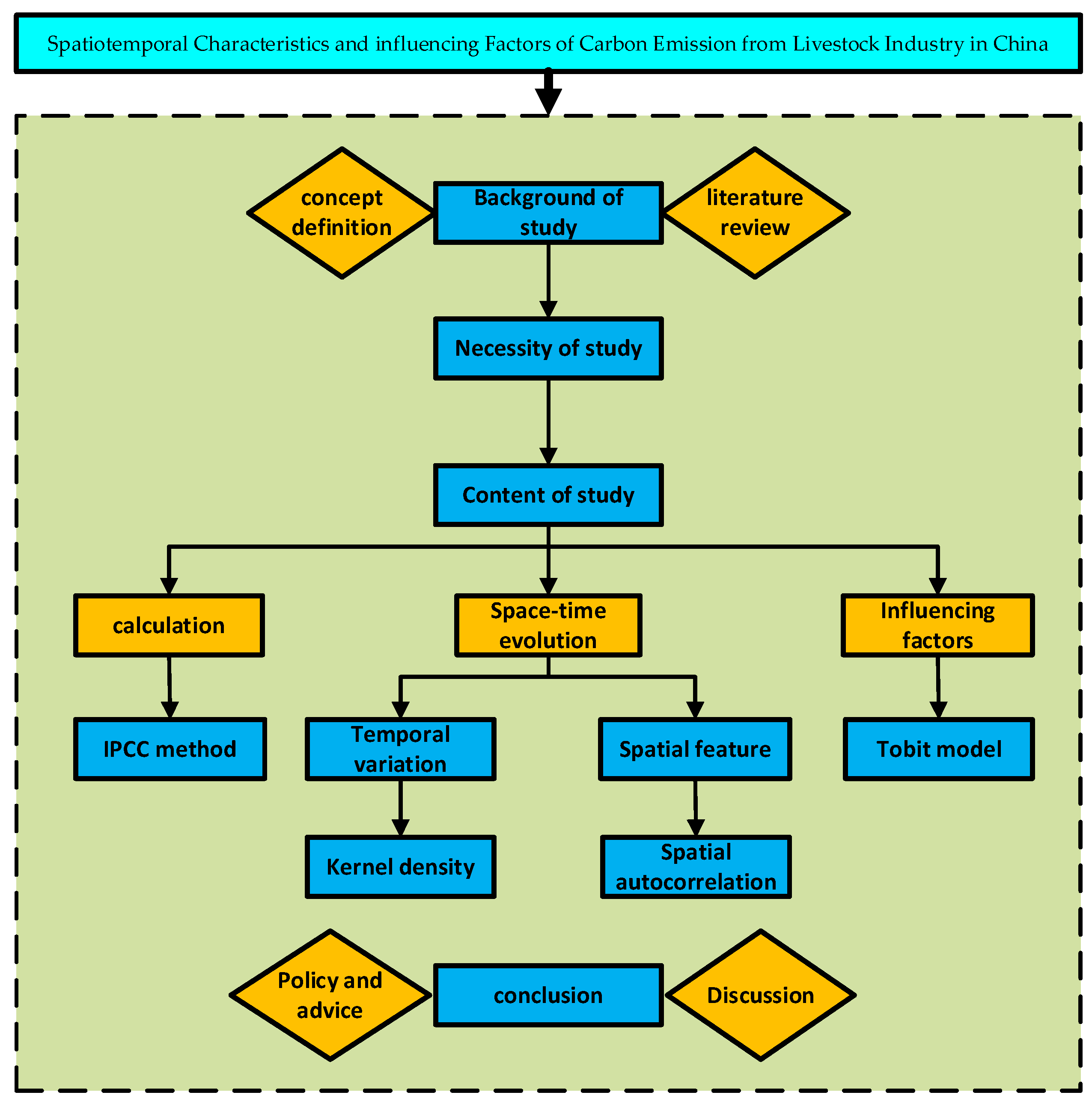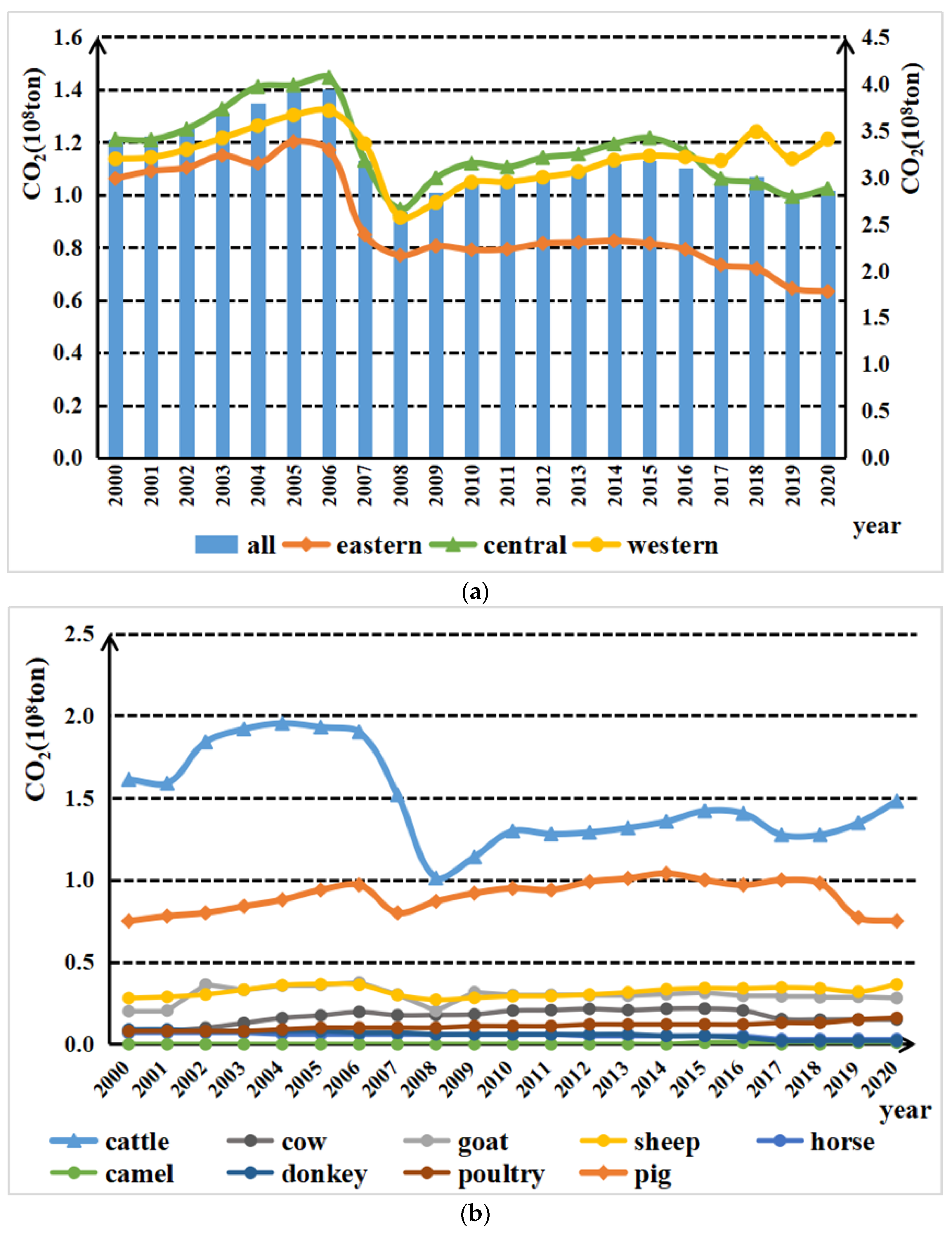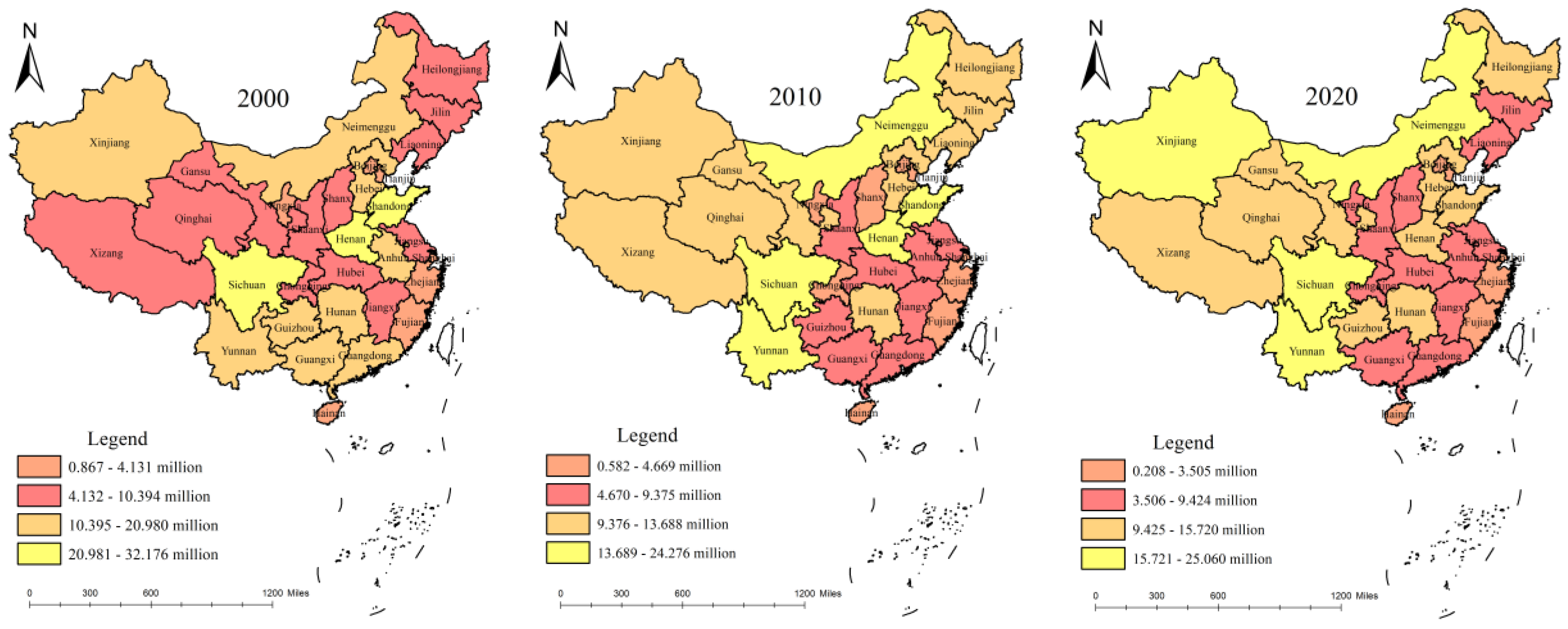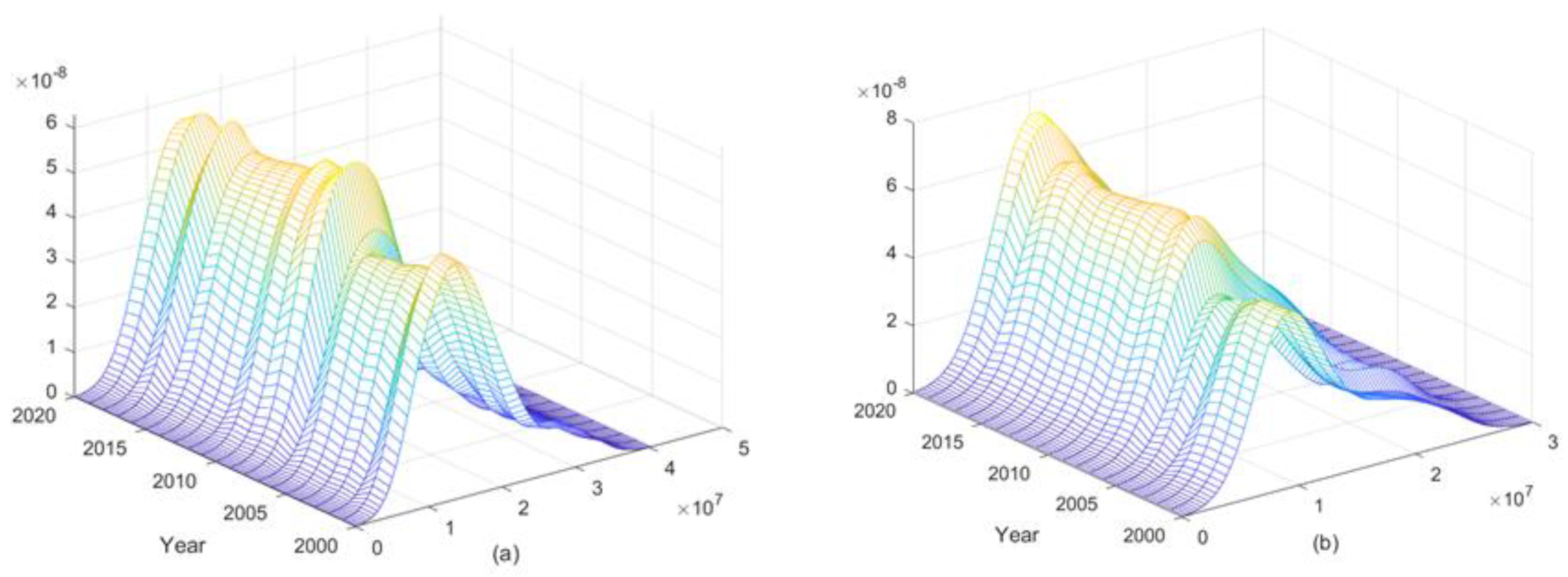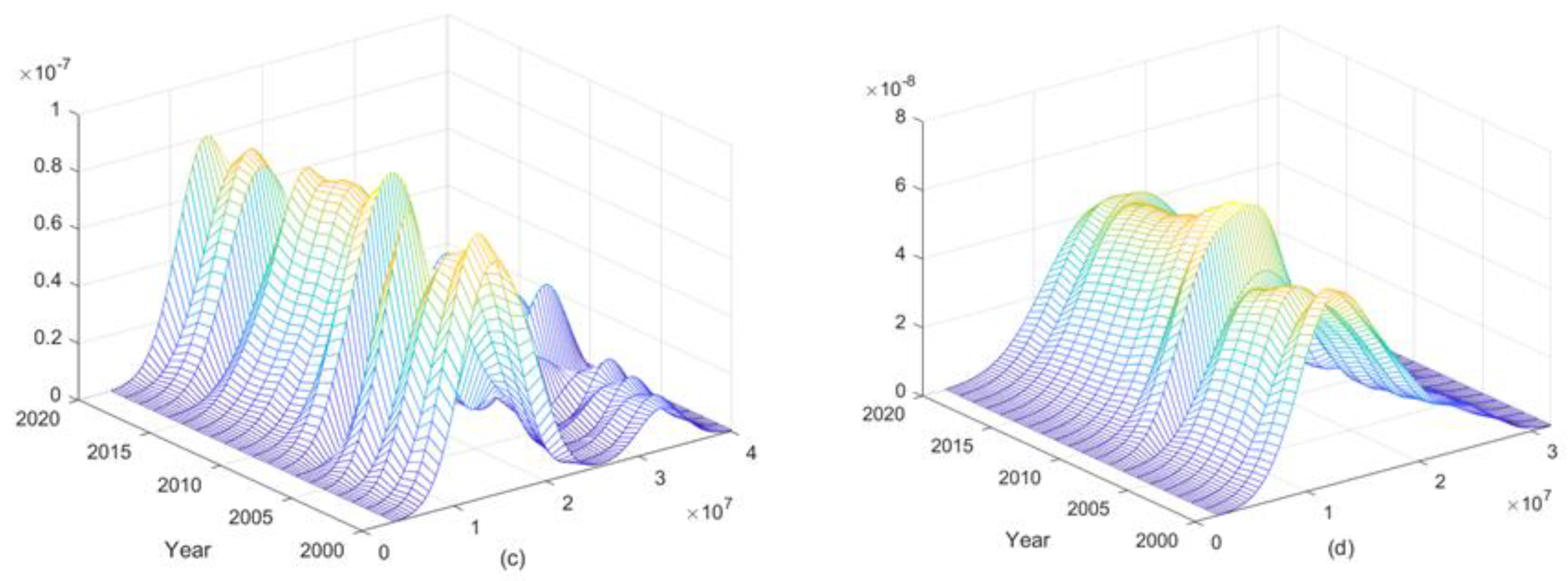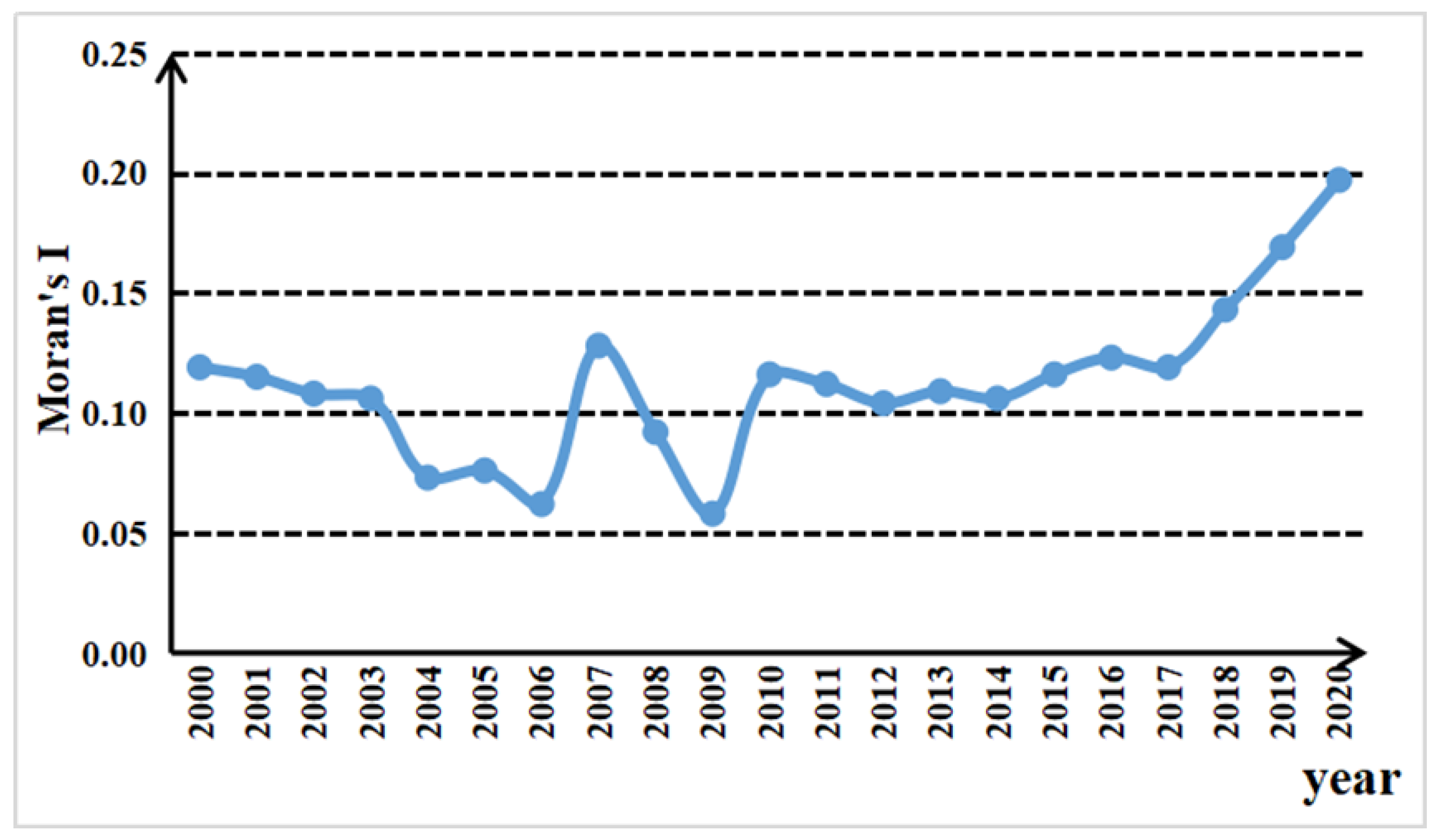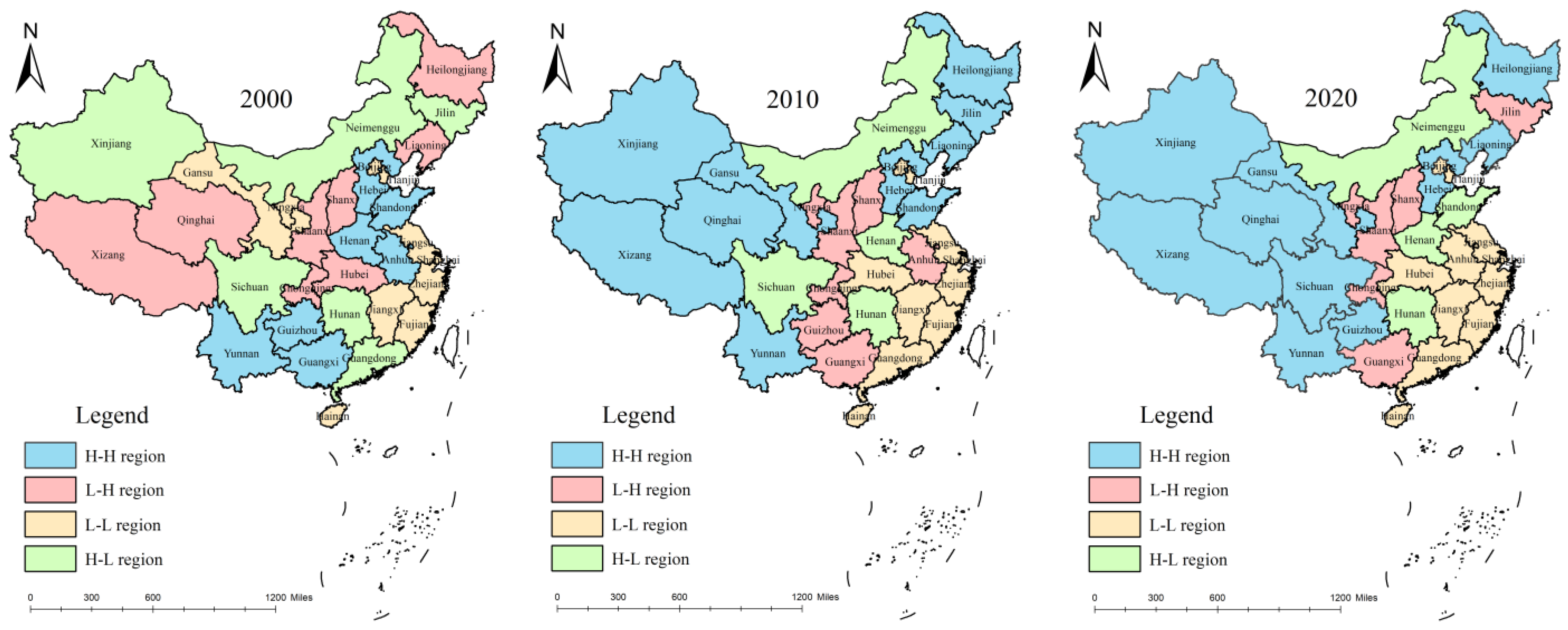3.1.1. Analysis of Carbon Emissions from Animal Husbandry
As shown in
Figure 2a, the 2000–2020 national livestock emissions, reduced from 340.8509 million
t-eq to 286.596 million
t-eq, experienced four stages:
(1) The rapid rise stage (2000–2005): animal husbandry carbon emissions rose from 340.8509 million
t-eq to 392.1207 million
t-eq with a growth rate as high as 15.04%. During this period, influenced by the continuous increase in grain production in the middle and late 1990s, grain supply was in large excess, and the increase in farmers’ income slowed down [
9]. In this context, China significantly accelerated the pace of agricultural structure adjustment, on the one hand, encouraging farmers to engage in animal husbandry production and actively promoting the scale, standardization, and industrialization, and on the other hand, adjusting the tax policies related to animal husbandry, gradually reducing the livestock tax year by year, the animal slaughter tax, and the tax rate, thus promoting the rapid development of animal husbandry. This in turn led to a sharp rise in livestock emissions, which peaked in 2006.
(2) The rapid decline stage (2006–2007): in two years or so, China’s animal husbandry carbon emissions fell from 393.5556 million t-eq to 317.3168 million t-eq with a decline of 19.37%. The possible reasons for the decline were that since early 2007, the international grain export prices rose sharply, and oil prices and transportation costs increased at the same time, facilitating the worldwide food crisis. China’s domestic grain market supply was tight, prices rose sharply, and to alleviate the pressure on the food supply, country began to restrict the grain-consuming animal husbandry. The number of non-cows, sheep, and other livestock was significantly reduced, and GHG emissions from livestock intestinal fermentation and manure management were significantly reduced, which in turn led to a rapid decline in total carbon emissions from animal husbandry during this stage.
(3) The slowly rising stage (2008–2015): the stage of animal husbandry carbon emissions rose from 262.886 million t-eq to 317.8069 million t-eq with an average annual growth rate of 2.61%. The possible reasons were as follows: with the increasing improvement in residents’ living standards, the demand for meat, milk, eggs, and other animal products continued to rise, and animal husbandry gradually recovered growth. However, compared with the first stage, because of the diversified development of the rural economy and industry, farmers’ income channels had continuously expanded, which reduced the proportion of agricultural income in the total household income to a certain extent and weakened farmers’ dependence on animal husbandry to increase income.
(4) Fluctuating decline stage (2016–2020): livestock emissions fell from 310.0198 million
t-eq in 2016 to 286.596 million
t-eq in 2020 with a decline of 7.65%. Possible reasons could be that on the one hand, from 2016 to 2020, China developed a series of animal husbandry carbon emission reduction policies and suggestions, such as
the Ministry of Agriculture and Rural Affairs on accelerating the development of animal husbandry mechanization opinion,
Technical specification for innocent treatment of animal manure,
the measures for the management of agricultural production development funds, and
the livestock and poultry breeding waste recycling use job evaluation implementation plan, etc. Regarding agricultural machinery, technical guidance, capital, and performance appraisal, the mechanization of animal husbandry and manure recycling were vigorously promoted, and the scale and intensification of animal husbandry production inhibited the carbon emissions from animal husbandry and promoted the high-quality development of animal husbandry [
39]. On the other hand, the outbreak of H7N9 in 2017, African swine fever in 2018, and COVID-19 in 2019 hindered livestock breeding to a certain extent, thus inhibiting carbon emissions from livestock farming [
40]. Therefore, although the total carbon emissions of the livestock industry in this stage increased in some years, the overall trend was a decreasing one year by year.
According to the line chart in
Figure 2a, by region, carbon emissions from animal husbandry in eastern, central, and western China all peaked in 2006. From 2000 to 2017, the broken line trends of the eastern, western, and central regions were basically consistent. In terms of the specific carbon emissions of each region, the central region produced the largest carbon emissions, the western region was lower than the central region, and the eastern region produced the least. After 2017, the carbon emissions from animal husbandry in the eastern and central regions showed a significant downward trend, while the carbon emissions in the western region showed a significant upward trend, and the carbon emissions in the upper western region exceeded that in the central region. By type, the top three livestock animals contributing to the carbon emissions were non-cows (including scalper, buffalo, etc.), pigs, and sheep. After 2017, the carbon emissions from non-cows and sheep showed an upward trend, while the carbon emissions of pigs showed a downward trend. Possible reasons are that, for the eastern and central regions, in recent years, because of livestock breeding pollution, especially the serious problems in pig breeding, the central and local governments established a series of restrictive measures for the pig breeding industry in some economically developed southern provinces. Some southern provinces with pig breeding populations reduced carbon emissions to a certain extent to promote animal husbandry. For the western region, on the one hand, in order to stabilize the Chinese pork supply, the central and local governments vigorously supported the development of the pig industry and provided assistance in terms of capital, policy, and technology. On the other hand, in China, much of the high-quality grassland and pasture land are located in the western region, and the main source of animal husbandry carbon emissions is the large amounts of livestock such as sheep, buffalo, and especially non-cow. The annual number of average breeding cows grew yearly, increasing the trend of carbon emissions and contributing to the proportion of animal husbandry carbon emissions in the western region.
With the support of the ArcGIS10.2 (Environmental Systems Research Institute, Redlands, CA, USA) software, the data of 2000, 2010, and 2020 were selected, and the carbon emission level of the livestock industry in each province was divided into four grades: high region, slightly high region, moderate region, and low region using the natural discontinuous point method.
Figure 3 shows that in 2000, the relative difference in the carbon emission levels from animal husbandry in China was obvious among the provinces, and there were many areas with moderate, slightly high, and high regions. The high regions were only in Sichuan, Henan, and Shandong provinces, whereas slightly high regions were in nine provinces: Xinjiang, Inner Mongolia, Hebei, Yunnan, Guangxi, Guizhou, Hunan, Anhui, and Guangdong. Compared to 2000, in 2010, the number of high, moderate, and low regions increased, the number of slightly high regions decreased, and the relative gap between the provinces narrowed. Among them, Inner Mongolia and Yunnan were upgraded from slightly high regions to high regions, while Guangdong, Guangxi, Guizhou, and other provinces retreated to a moderate region. At the same time, the preliminary highlights of China’s animal husbandry carbon cluster characteristics presented a concentrated zone “block” distribution. The slightly high regions such as Xinjiang, Tibet, Gansu, Inner Mongolia with the high regions such as Sichuan and Yunnan are connecting as an organic whole. The animal husbandry high and slightly high regions tended to be located in the western region. By 2020, the number of high regions decreased by two, but the number of slightly high regions increased again, and the relative gap among the provinces widened. Among them, Shandong and Henan provinces changed from high regions to slightly high regions, Xinjiang from a slightly high region to a high region, and Qinghai and Guizhou provinces from moderate regions to slightly high regions. At the same time, the distribution characteristics of the “block” of the concentrated contiguous area were further clarified. The regions with the high carbon emissions of the livestock industry and the regions with slightly high carbon emissions were obviously located in the western area, and the distribution characteristics of the “block” of the concentrated contiguous area were also further clarified, specifically, the carbon emissions and the regional distribution of the high and slightly high regions in Inner Mongolia, Xinjiang, Gansu, Qinghai, Tibet, Sichuan, and Yunnan provinces. The slightly high and moderate regional distributions are located in prairie areas such as Shandong, Henan, and Hebei provinces, and major grain-producing areas in three provinces in the northeast, and the low region is located in Zhejiang, Shanghai, Jiangsu, Fujian, and the southeast coastal provinces. In general, carbon emissions from animal husbandry showed a significantly decreasing spatial distribution pattern from the northwest to the southeast.
3.1.2. Time Evolution Trend of Carbon Emission from Animal Husbandry
Previous studies on the dynamic evolution of carbon emissions from animal husbandry have mostly adopted the two-dimensional planar kernel density model. The limitation of this method is that only the two-dimensional kernel density curve of the research object can be selected to represent the year. In this paper, the three-dimensional kernel density curve of all the study years was drawn with the help of MATLAB software. It can very carefully, accurately, and completely reflect the dynamic evolution process of carbon emissions from the livestock industry in each province of China.
In order to clarify the overall distribution and change trends of carbon emissions from animal husbandry in different periods in the eastern, central, and western regions of China, we plotted the kernel density estimation of carbon emissions from animal husbandry for the whole country and the eastern, central, and western regions from 2000 to 2020, as shown in
Figure 4.
Figure 4a depicts the distribution dynamics of carbon emissions from the livestock industry in China. From the movement of the wave peak, the main peak of the carbon emission distribution curve of the national livestock industry shifts to the right first and then to the left, indicating that carbon emissions from the national livestock industry experienced a change process of first increasing and then decreasing. The height of the main peak experiences a process of “upward-downward-rising”, and the width of the peak increases continuously, indicating that the relative gap among the carbon emissions from animal husbandry in various provinces in China narrowed first and then expanded.
There was a tailing phenomenon, but the scope of the right drag decreased, indicating that the difference between the provinces with the highest and lowest carbon emissions from animal husbandry is decreasing.
Figure 4b–d, respectively, displays the features of three regional (eastern, central, and western) animal husbandry distribution dynamics of carbon emission levels. From the point of distribution location, the eastern part of the main nuclear density curve shows a trend of distribution to the left, along with the central region, and the western region shows a trend of right distribution, indicating that in recent years, animal husbandry carbon emissions in the eastern and central regions have declined. The eastern region had a faster downward trend than the central region, while the carbon emissions level of animal husbandry in the western region experienced an upward trend. The possible reason is that the eastern region has a more developed economy and a higher level of mechanization and technology in farming and animal husbandry, which promoted the carbon emission reduction goal of animal husbandry. However, the mechanization of agriculture and animal husbandry in western China is still in its initial stage, and the increases in production and income depend more on factor input than on technological progress. With the support of national policies to encourage the development of animal husbandry in western China, it is inevitable that carbon emissions will continue to increase in the short term. In terms of distribution extensibility, there was an obvious tailing phenomenon in the eastern and central regions, indicating a certain spatial difference between the provinces with the highest carbon emissions and other regions. The central region in particular formed a small wave to the right, and the main representation of most of the province formed a bigger difference. The reason may be that central Inner Mongolia’s autonomous region is a major animal husbandry province of the country; the natural resources are superior, it has much high-quality, grassland, pasture animal husbandry, rich resources, farming on a large scale, and the animal husbandry carbon level is higher. There is a certain spatial spillover effect on the carbon emissions from the livestock industry in the neighboring province, which affects or even increases this level and forms a higher level of carbon emissions area within a certain range. However, in the western region, there was no obvious tailing phenomenon, and the spatial distribution was balanced. The animal husbandry carbon emission levels in all provinces were basically the same, at a high level. The reason may be that China’s four big pastoral areas [
32], in addition to the pastoral areas of Inner Mongolia, Xinjiang, Tibet, and Qinghai, are located in the western region. On the one hand, the highland pastoral areas have strong sunlight during the day, a large temperature difference between day and night, sunny days, and many natural advantages, such as areas for forage growth and sugar storage and adequate supplies of high-quality foraging. On the other hand, the high altitude and cold climate greatly reduce the possibility of epidemics and the outbreak of livestock infectious diseases. The survival rates of large livestock such as non-cow, sheep, and horses are high, and the average annual feeding volume is high. Therefore, the overall carbon emission level of the livestock industry in the region is high, and the difference is not obvious.
